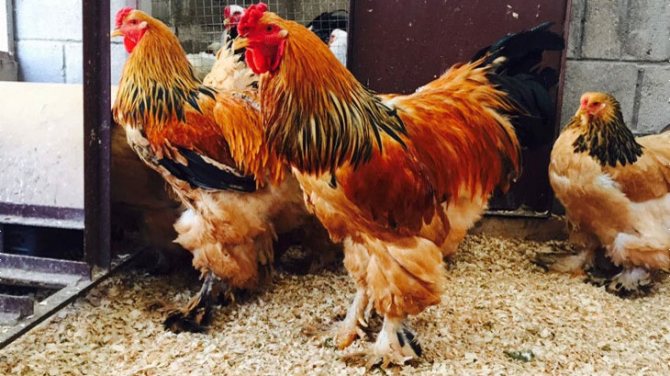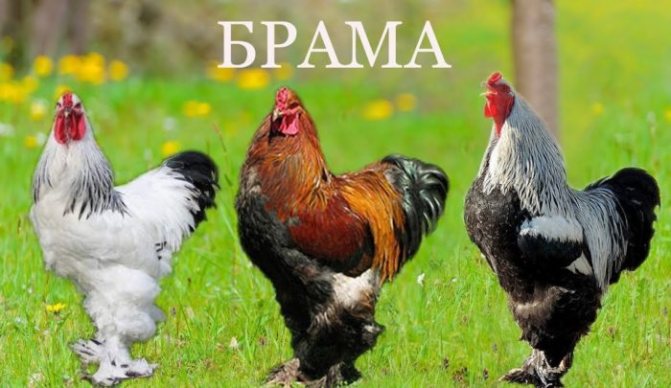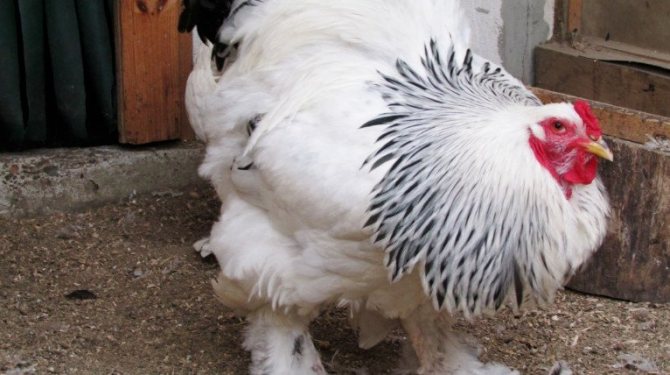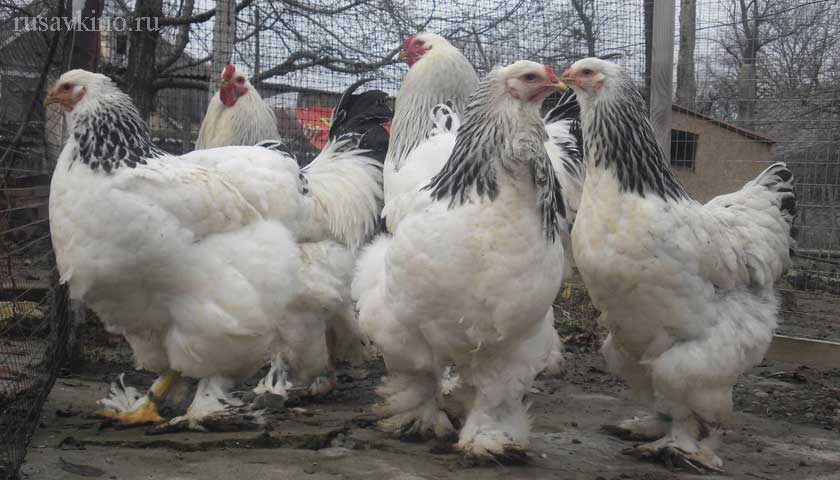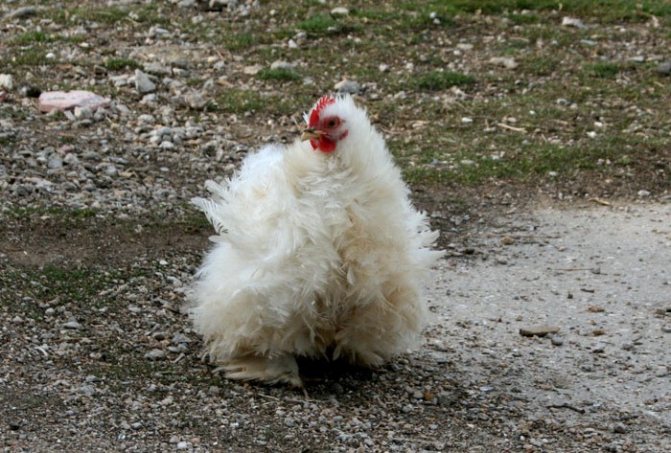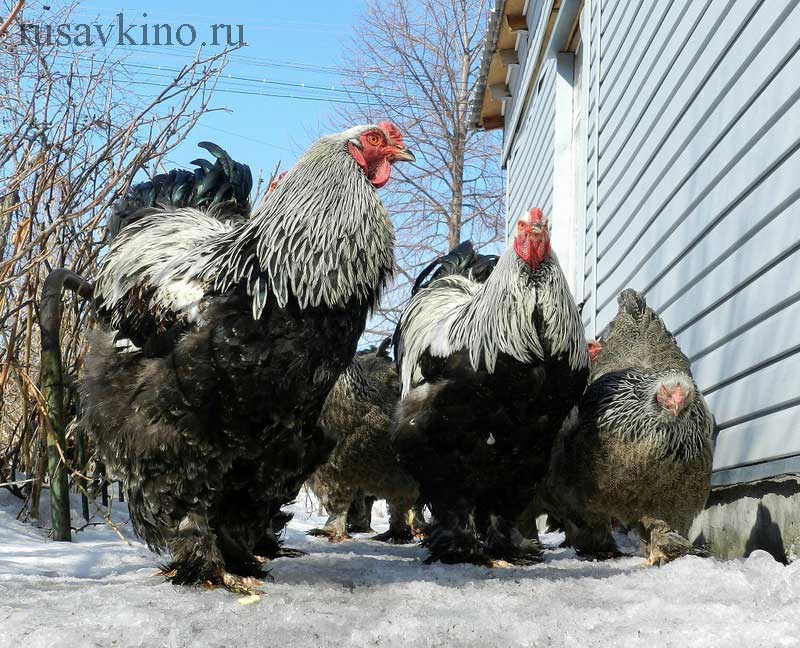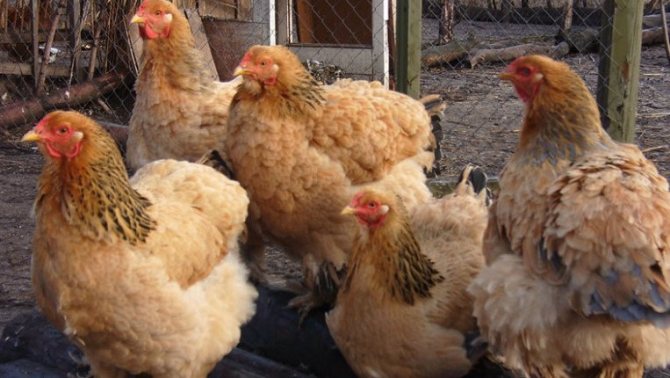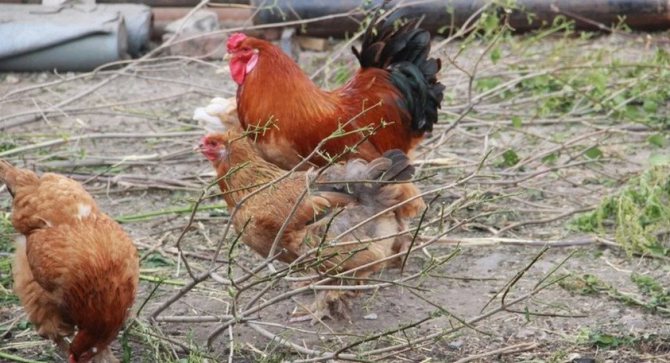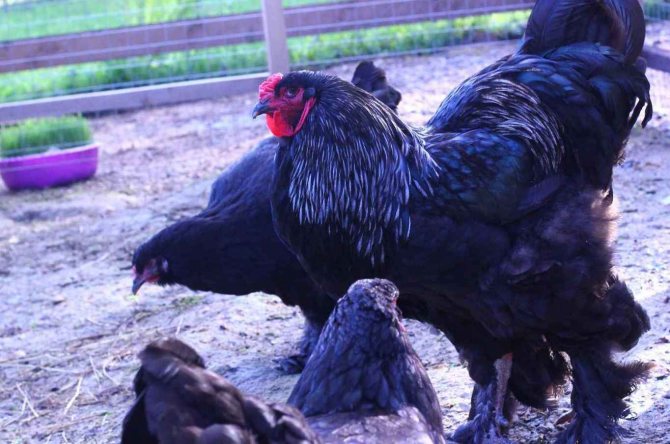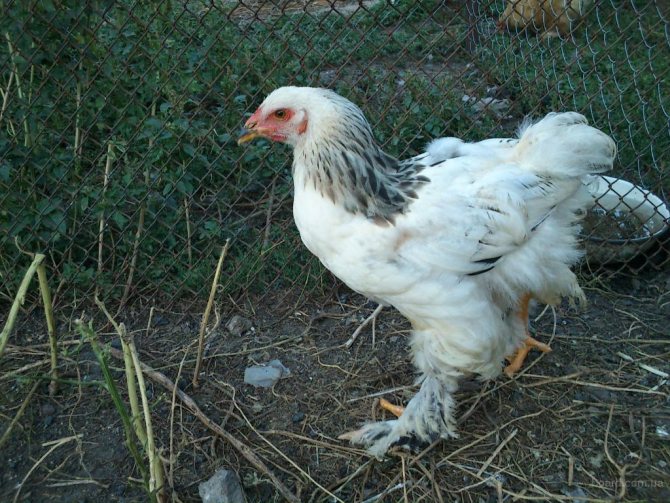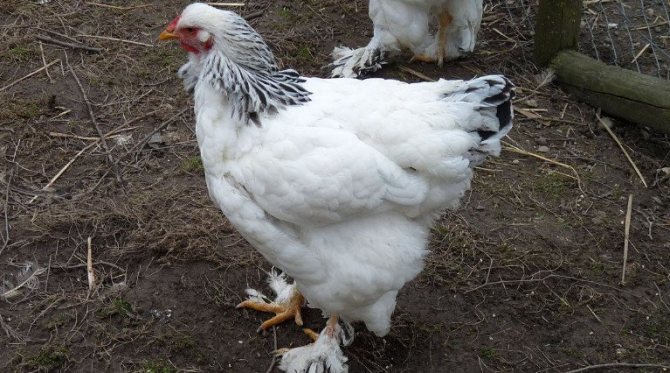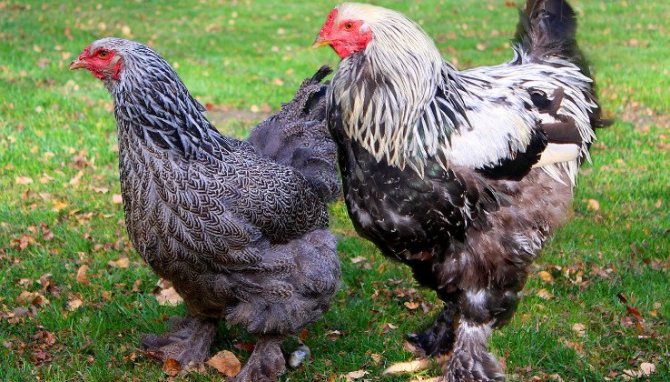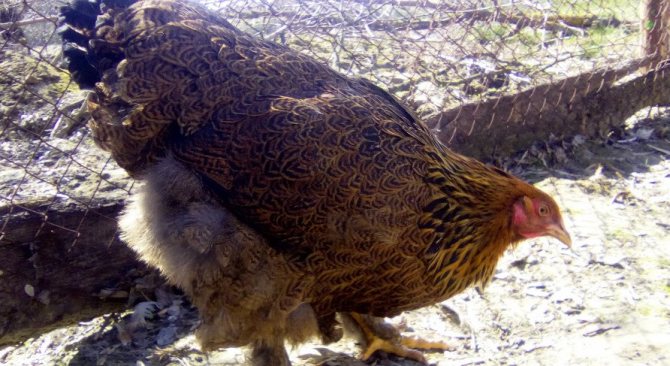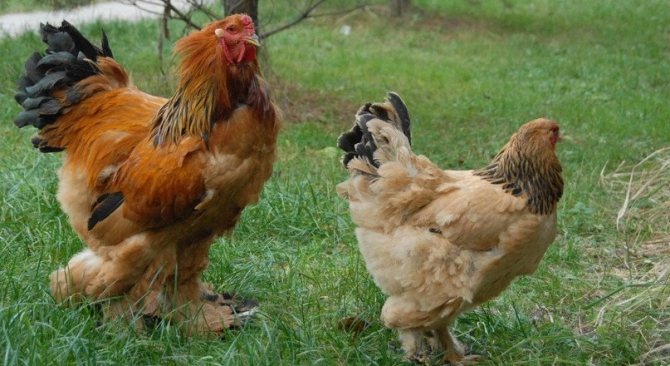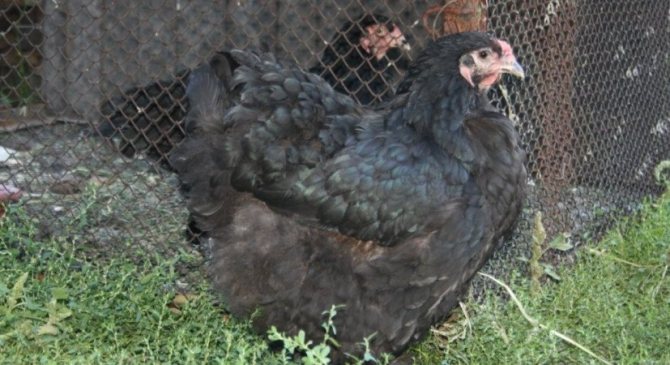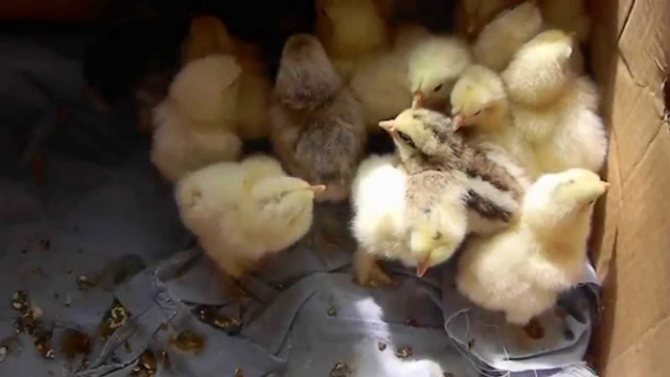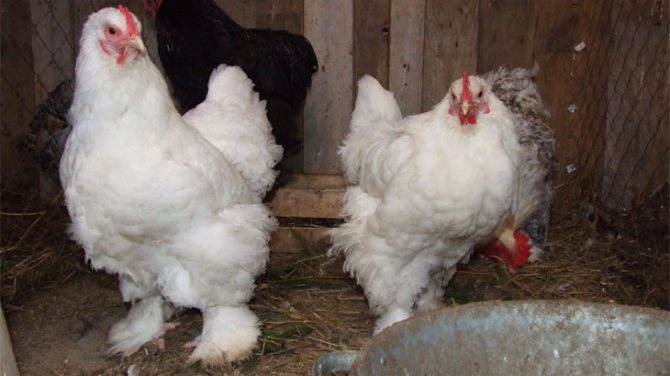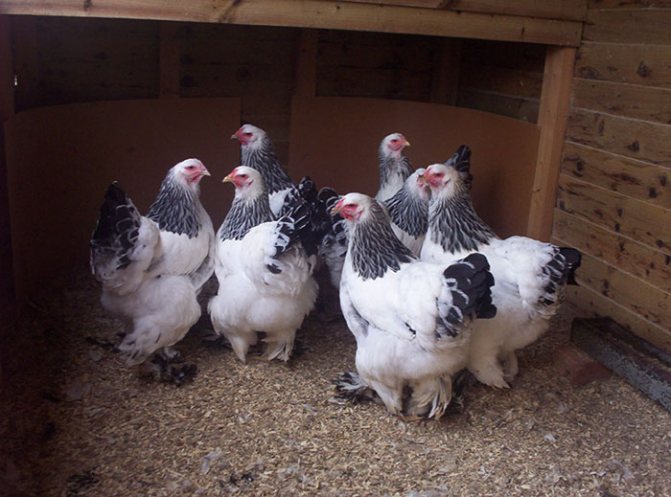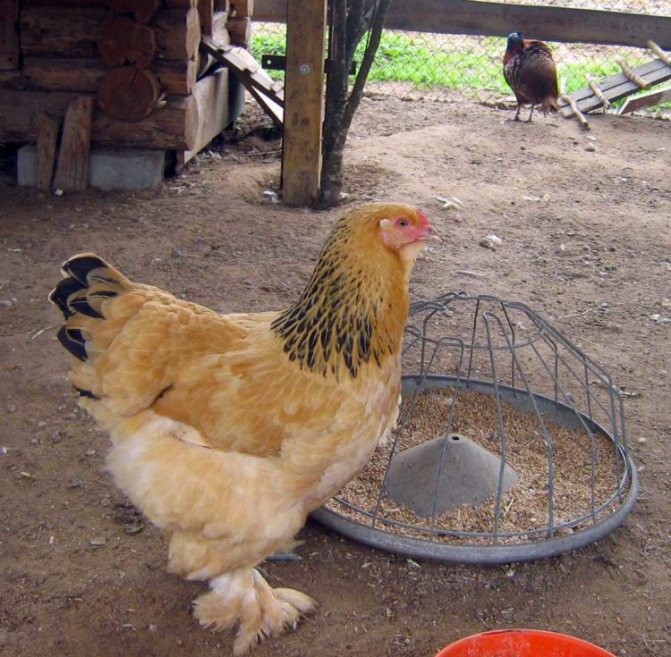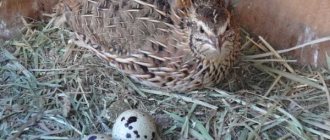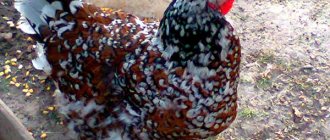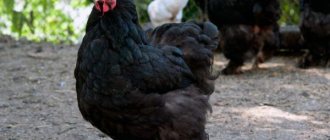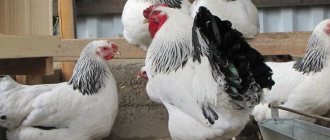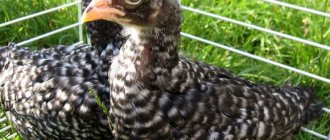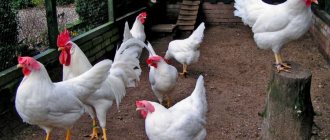The history of the breed
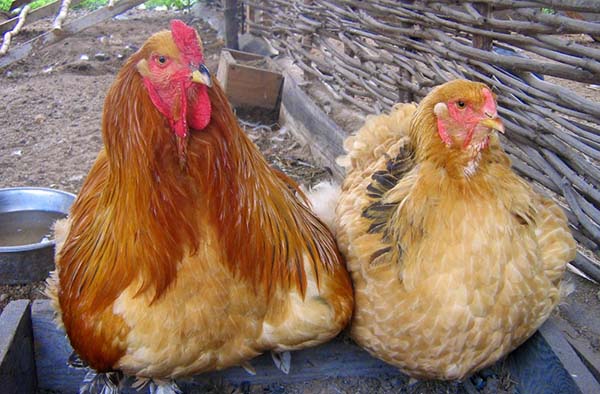
In the middle of the 19th century, the Americans brought huge Asian Upland birds from India in order to obtain a productive meat breed with attractive appearance. Asians were crossed with Kokinkhin, Chittagongs and Malay fighting chickens. The wild concoction gave rise to the Gray Chittangong, large, humble birds that provide dietary meat. Scientists presented a new species in 1850. Two years later, the name of the chicken breed already sounded like "Brahma".
In Russia, this breed was wildly popular at the beginning of the 20th century. Research shows that Brahmas were among the five most common poultry on peasant farms. They were widely bred to produce large, tasty carcasses. With the advent of new, more early maturing breeds and crosses, Brahmas ceased to be the leaders of their segment. Today Brahmins are grown exclusively for the contemplation of their beauty. On an industrial scale, chickens are not bred.
Interesting!
At the dawn of their development, chickens of this breed grew really gigantic. The mass of an adult male could reach 7 kilograms. Crossing Brahm with other species for decorative appearance led to a decrease in the size and weight of the birds.
Where can you buy in Russia?
Due to its meat qualities, unpretentiousness and endurance, as well as calm disposition and good egg production, Partridge Brahma ranks second among the breeds of chickens that are bred in Russia.
Many farms offer their products to customers: poultry meat, eggs, chickens, young animals and even pedigree producers. Below is a small overview of Russian farms that breed Partridge Bram.
Description of the breed
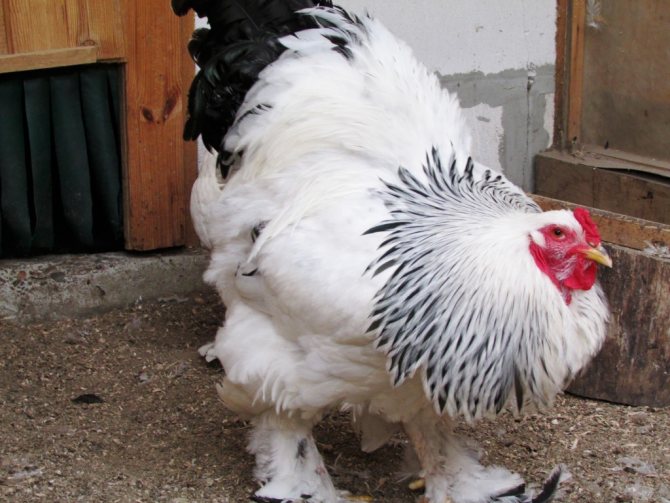

The breed of chickens Brahma has a number of peculiarities characteristic only of it, among which it is possible to single out unpretentiousness to conditions of detention and food, a humble disposition and spectacular external data.
Exterior features:
- Modern Brahmas are lighter in weight compared to their ancestors. The live weight of the cough is 3.5 kilograms, the cockerels - up to 5 kilograms.
- The color can be different, from silver-white to partridge and red. There are subspecies with colored plumage. Down is always white, there is a lot of it in the lower part of the body and on the legs. The skin is yellow.
By the way!
A memorable feature of the plumage of roosters is the presence of a fluffy variegated collar around the neck.
- The head is small. The crest is pea-shaped, weakly serrated, soft. The neck is not long, densely feathered in the upper part. The beak is short, yellow. The eyes are depressed, orange. Earrings and lobes are bright red.
- Brahma is a dense, fleshy, massive bird. The seating position of the body is high. The body is wide, the chest is round. The bushy, likely tail is lifted up. The wings are developed, but they are not able to lift a heavy carcass.
- The legs are long (shorter in females), the skin is hidden under the feathers.
A marriage is considered:
- the presence of yellow in the plumage;
- whitish tail;
- bare legs;
- white metatarsus;
- the light Brahms have black strokes on the lower back.
Fact!
Brahmin meat is the most tender, juicy and dietary among other breeds of a similar direction. Improper, poor feeding makes the meat fatty or, conversely, dry, often unsuitable for cooking.
Brooding instinct
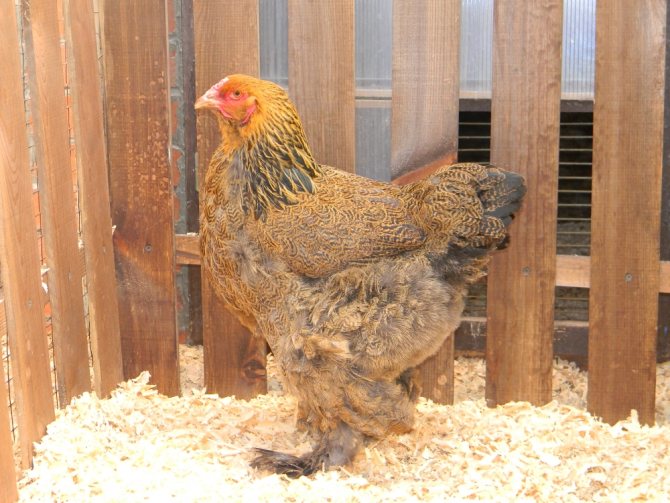

Brahma hens are good brood hens. Their maternal instinct is fairly well developed. For incubation, it is better to plant females for 2-3 years, since they carry the highest quality eggs. However, problems often arise when raising young. The fact is that, due to the large weight, hens often crush their eggs. So you can lose up to a quarter of future chicks. From this, the indicators of safety relative to other breeds are low: up to 68% of chicks survive.
Therefore, many poultry breeders choose to breed Brahms by laying eggs under smaller breeds or using incubators.
Character
These giants have a humble disposition. Birds are slow and lazy. They do not like to get their own food, they like it more when they are fed, and the more, the better. Phlegmatic giants get along easily with other pets. At the same time, they know how to stand up for themselves. It is known that roosters can protect their family from dogs, cats and birds of prey.
Egg production
Layers do not have high egg production. All they can give is 120 eggs a year. Egg mass - 50-65 grams. The shell is strong, it can be dark brown or beige. The main feature of the Brahminoks is the continuation of egg-laying in winter. When other breeds reduce egg production in winter or stop laying altogether, Brahma females retain their performance.
Varieties of the Brama breed
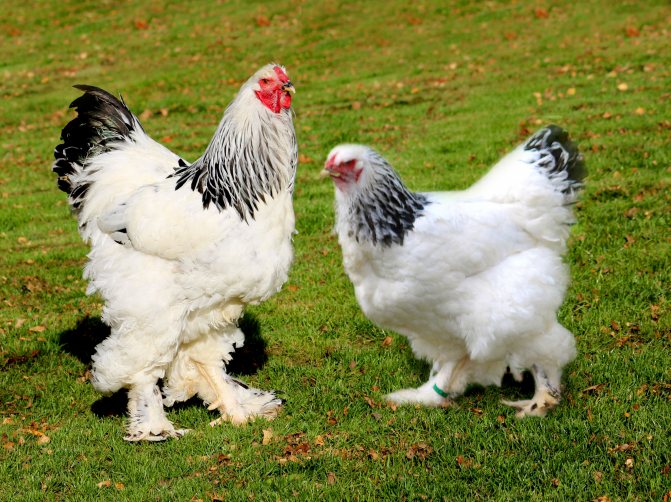

There are several types of Brahms. They are distinguished by the productive focus, size and color of the pen. Distinguish between meat American, decorative European, Asian decorative meat, dwarf. Brahma subspecies: light, dark, partridge, fawn.
Types of Brahms
| Name | Characteristic |
| Light | Colombian plumage. In chickens of this variety, the plumage of the body is white with a silver tint, the head and tail are painted in black with an emerald tint. The comb, earrings and lobes are painted bright red. By the way, the presence of a yellow tint on the feathers is considered a marriage. Light Brahmas are large roosters with strong long legs and not too large females with a more compact build. The mass of males can reach 7 kilograms, but roosters with less weight are more common - only 4-5 kilograms. Chickens weigh 3.5-4.5 kilograms. Late ripening pullets. They bring their first eggs at 8-9 months. Clucks rush reluctantly, yielding a maximum of 120 eggs per year, weighing up to 60 grams. The shell color is light brown. Productivity is maintained for two years, then egg production drops sharply. |
| Dark | Females of Dark Brahma have gray, blue-gray plumage of the body. The head is covered with a black feather, black and white colors may be present. Black stripes on the chest and sides. Roosters have predominantly black plumage. Only the head, scruff and back are silvery-white. In other characteristics, Dark Brahma is similar to Light. |
| Fawn (buff) | Fawn birds are large, powerful, sinewy. Feather color is light brown, red. In females, the head and tail have a darker shade. Males have a pure black tail with dark stripes on the sides, back and nape. If there is a large percentage of red and yellow feathers, this means that the individual is not purebred. The productivity of this chickens is not bad. Females produce 100-120 eggs per year. Live weight of individuals: female - 4 kilograms, male - 4.5-5 kilograms. |
| Partridge | American selection. Individuals have a fawn plumage with a partridge pattern all over the body. Even on the shells of partridge chickens, you can notice a kind of dark specks, reminiscent of the mother's color. Roosters are colored differently: the head, neck and scruff, turning into the back of a red-orange color, and all other parts of the individual are black. By the way, the presence of extraneous colors is a serious deviation from the standard. Partridge Brahmas are relatively light in weight.The weight of males barely reaches 4 kilograms, and chickens weigh 3.5 kilograms. Egg production of laying hens is 110 eggs per year with the weight of one egg 55-60 grams. |
Breed benefits


- the possibility of getting tasty meat;
- ease of content;
- in winter, the number of eggs does not change;
- decorativeness.
disadvantages
- frequent obesity of birds due to low mobility;
- late egg production;
- a large percentage of the death of chicks;
- slow growth of young animals.
Productivity
Brama chickens are considered meat-eating. But more and more often they are bred as decorative ones. The meat of birds of this breed is tough. It is valued more for its dietary properties and nutritional value. The average weight of eggs is 55 g. When compared with other breeds, they begin to hatch late - at 8 months. The number of eggs laid is an average of 110 eggs per year.
At the age of two years, the productivity of chickens drops sharply.


Brama chickens have a very well developed hatching instinct, but given their large weight, it is better not to use them for this purpose, since up to a third of the eggs can be crushed. It is better to put eggs with a stronger shell under the chickens of this breed: goose or duck.
Keeping chickens
There is no need for the Brahms to build spacious enclosures. Not distinguished by their playful character, the birds feel good in a closed chicken coop and a small outdoor yard. Due to their heavy weight, chickens do not have the ability to fly, and therefore it is better to install perches not high from the floor, at a height of about 35-40 centimeters. The duration of daylight hours should be 12-14 hours a day.
You may be interested in: How to feed laying hens in winter at homeHow to make an automatic feeder for chickensWhat to treat coccidiosis in broilers at home
You do not need to close the house for the winter. Brahmas are not afraid of cold weather, they like to walk in the fresh air even in winter. It is not necessary to additionally supply the chicken coop with a battery.
It is recommended to use sawdust as bedding. If the floor covering gets wet, you must immediately refresh it. The presence of an ash bath in the hen house makes the stay of chickens more comfortable. They willingly bathe in ash, cleansing the skin of parasites. The height of the outdoor enclosure can be small - the chickens will still not be able to fly over the fence.
Brahm food
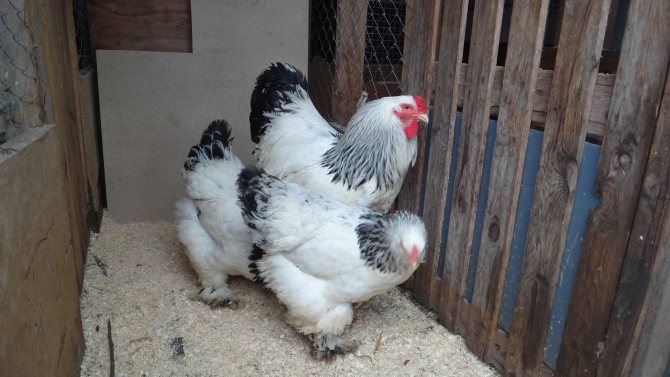

The diet of meat breeds should be balanced and varied. Brahmas have a tendency to constantly bite something, however, overeating often leads to obesity. As a result, the meat becomes too fatty, not tasty. With a shortage of feed, young animals stop developing.
Attention!
For the smooth functioning of the intestines, river sand or gravel crumbs are added to the diet of chickens.
Chickens gain weight slowly, so it is necessary to add a lot of protein to the grain. Fish, grass flour, dairy and sour milk products, meat broths are added to the menu of monthly chicks. Vegetables and herbs serve as a source of vitamins - these ingredients should be "on the table" in chickens every day.
Limited feeding is used for the Brahms. Diet - 2 times a day. The type of feeding is mixed - it is necessary to alternate dry food and wet mash. One pack unit consumes up to 200 grams of food per day. In winter, the amount of feed is increased by 10%, since the main energy of the bird is spent on heating the body. Additional doses of vitamins are added to the diet. In winter, chickens often suffer from vitamin deficiency, they can get sick. You need to maintain health with the help of sprouted grains, rich in vitamins with the addition of fish oil. It will not be superfluous to use the drug "Tetrahydrovit" - a source of vitamins and amino acids.
It is customary to give protein food in large doses only to young animals. As we age, protein needs to be reduced so that bone development and muscle build-up are even.
In addition to food, chickens must be provided with clean fresh water.The water in the drinking bowls should be changed daily, making sure that the water tank is clean. At least once every 7-10 days, a little potassium permanganate is added to the drink in order to prevent the development of diseases.
Feeding
One of the distinctive features of brama is excellent appetite, and as a result, a tendency to obesity. Therefore, poultry farmers must understand how to properly feed the brama. It is necessary to constantly monitor how the bird is gaining weight in order to correct the amount of food in time.
Breeders recommend three meals a day at the same time.
The diet should be balanced:
| Age category | Basic diet | Mineral supplements |
| Brama chickens of the first days of life | Chopped boiled eggs (at the rate of 1 pc. For 25 chickens) + finely ground boiled wheat or corn grits | |
| From the 5th day | Eggs are replaced with low-fat cottage cheese, vegetables (carrots, beets, zucchini) + chopped greens (carrot tops, cabbage leaves, nettle, dandelion) are added | |
| From 2 weeks | The porridge is replaced with a wet mash of cereals with kefir, yogurt or broth (30-40 g per head) | Fish or meat and bone meal |
| From 1.5 months | Replace crushed grain with whole grain, introduce compound feed and bran into the diet | Crushed chalk, meat and bone meal and fish meal, finely ground (pre-boiled) eggshell |
| Adults | Wet mash (30 g), whole grains (up to 55 g), boiled potatoes (100 g), hay flour (10 g) + chopped brilliant green and vegetables | Crushed chalk, shell rock, eggshells, meat and bone meal, coarse sand or fine gravel |
For meat poultry, the grain content in the daily ration can be increased by 15-20%. Make sure that the drinkers are always filled with clean water. As additives, fish oil and corn meal are mixed into the feed. In specialized stores, you can buy vitamin preparations that are appropriate for the age of the chickens.
A little trick: in order to stimulate the motor activity of chickens, it is advisable to sprinkle up to 10% of dry food directly on the floor, spread large vegetables (zucchini, cucumbers, pumpkin) around the chicken coop.
Breeding features
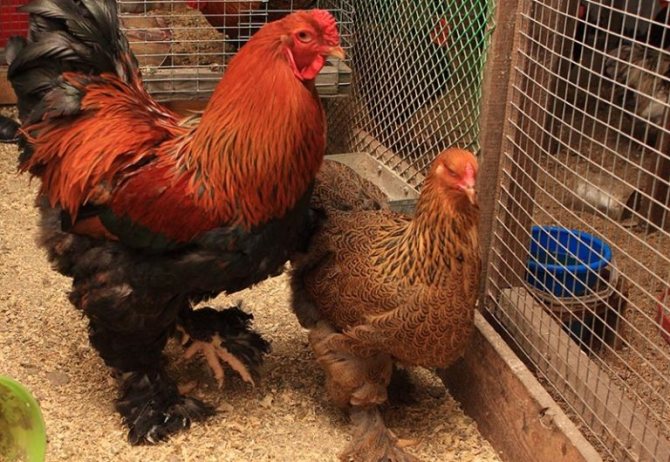

There are usually no problems with increasing the flock, since chickens are excellent brood hens, and roosters are good treadmills. There are up to 15 females per male. All of them can be kept together - hens living together with cockerels feel more protected.
Chickens are bred in the spring, because it is known that chicks bred in the middle of summer develop worse and do not have time to get stronger by winter. As a result, the mortality rate rises sharply. The largest and freshest eggs are chosen for hatching young animals. 9-11 eggs are laid under one hen. At this time, Kluffs are very calm, they rarely leave the nest, preferring to be with their brood every hour. Chickens are born with a small fluff. For the first three months, the young are next to their mother. They are then kept separate from other breeds and adults. Chicks grow for a long time, but they have a lively, curious character.
Diseases
Brahmas often pick up infectious diseases and parasites. This is mainly due to violations of sanitary and hygienic standards of maintenance. Since most microbes accumulate under the litter or in its layers, it is necessary to regularly change straw or sawdust, do not let them get wet. By the way, wet lumps of droppings, feed and plant waste stick to the feet of chickens, which can cause leg diseases and injuries.
Ash or ash baths save from parasites.
For preventive purposes, all young animals are subject to compulsory vaccination against bird flu and other infections. For rickets, fish or fish oil is added to food. With vitamin deficiency, the dose of vitamins and minerals is increased.
Chickens
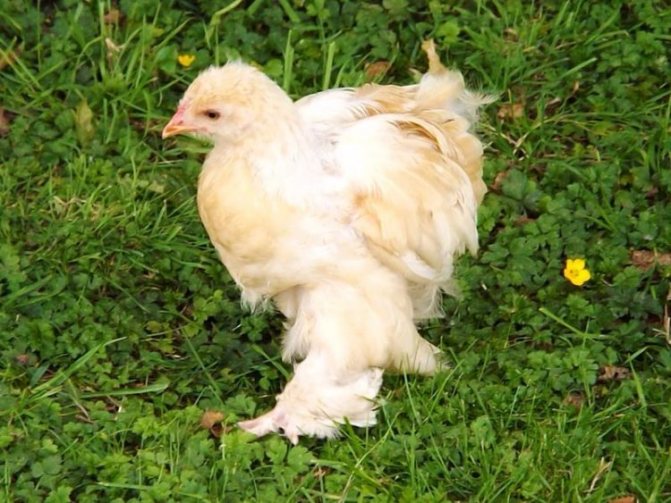

Unlike many meat and egg chicks, babies do not grow as fast. But, quite confidently, they gain weight, and fledge, too, without problems. Cubs of this species can be born in different colors, and this depends on their genetic inheritance.The rules of keeping and feeding these babies are not far from the traditional ones.
Consider a few recommendations for caring for and feeding them:
- To avoid developmental defects, it is worth focusing on a balanced diet. In addition to feed mixtures, greens, vegetables, chalk, vitamins and dairy products are added to the cubs.
- Chicks, which from the first days live under the supervision of a shaggy mother, as a rule, grow stronger and healthier. Therefore, if possible, you should organize a joint stay in good conditions.
- Feeding at an early stage of development promotes good appetite and protects the offspring from starvation. The smallest chicks are given food 6 times a day, and from 3-4 weeks they can be fed 4 times a day.
- The crumbs are sensitive to pathogens, so it will not be superfluous to regularly sterilize or disinfect the dishes.
- May the chicks always have clean water. During the first weeks, it is necessary to ensure that it is warm, because the crumbs have a high body temperature and cold water can provoke hypothermia with all the ensuing consequences.
Replacing the herd
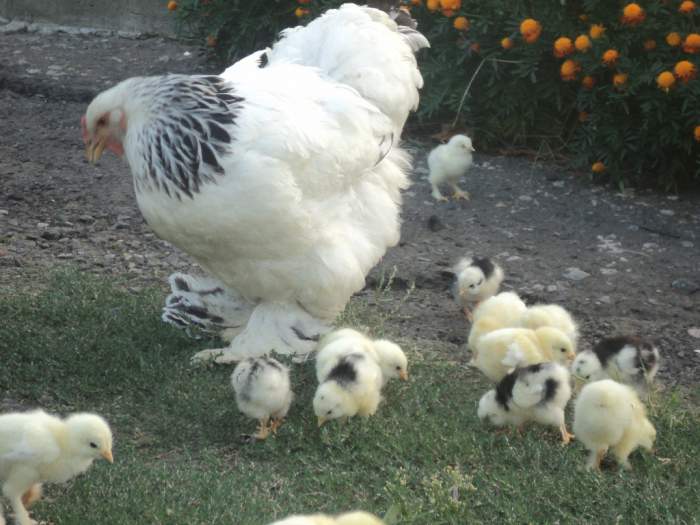

Laying hens show tolerable egg production for the first two years, then the number of eggs brought is sharply reduced. They can continue laying eggs for another 2-3 years, but there is no point in keeping "empty" chickens. For hatching young animals, 2-year-old hens and one-year-old cockerels are used. The most delicious meat is for males 1 year old and females 1-1.5 years old. If chickens are bred for meat, then they should not be kept longer.
Reviews of poultry farmers
According to poultry farmers, Brahma is a difficult breed to grow. The "inhibitory" development of young animals takes a lot of energy. The first egg of a female Brahm is given later than other breeds, not earlier than 8 months. They carry few eggs. And there is not a lot of meat from them. Reviews point to "not too tasty meat." In addition, birds are prone to obesity, as they are very infantile and inactive. Excess weight naturally affects the quality of the meat. However, there are pluses in the content of this breed. Brahmas are expensive chickens, so meat and eggs can be sold very profitably. In addition, adults have a bright appearance; you can even keep these birds in your yard purely because of their decorative qualities.


